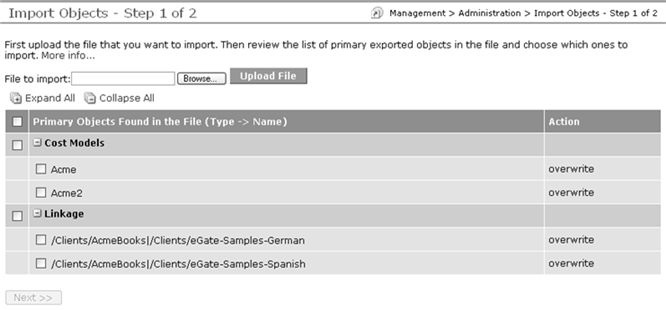After you have exported WorldServer objects, you can import them into another instance of WorldServer.
When you import objects, the custom components referenced by those objects are not imported with them. For example, if you want to import a workflow that contains custom automatic actions, you must add or import those custom automatic actions from
before importing the actual workflow.
Moreover, certain dependencies that do not exist in the target system such as users, workgroups, workflow rules, and clients will not be imported alongside access control lists (ACLs). You must add those dependencies or import them separately into the target system.
-
Go to
.
-
Upload the file that you want to import by clicking
Browse, locating it, and then clicking
Upload File.
The primary objects included in the file are displayed in the
Import Objects list:
Figure 1. The Import Objects list

Note: The
overwrite value in the
Action column indicates that the object already exists in that WorldServer instance and that you will overwrite the existing object if you import it again.
-
Select the check boxes next to the objects you want to import, and then click
Next.
-
On the
Import Objects - Step 2 of 2 page, select one of the available import options.
If you select
Include missing referenced objects, WorldServer displays only the objects that are referenced by the primary objects you selected and that are missing from your server. If you select
Include all referenced objects, WorldServer displays all the objects that are referenced by the primary objects you selected. In the list, referenced objects are marked with a star next to their names.
Important: If you import clients by selecting
Include all referenced objects, the configurations of default user types are overwritten, which means that permissions are also changed according to the imported configurations.
The list of objects is analyzed automatically when the page is loaded and when you change the import option. The analysis searches for the following conditions:
- A primary object references a dependent object which is neither in the XML file, nor in the target system.
- A referenced object references a dependent object which is neither in the XML file, nor in the target system.
If any of these conditions is found, you cannot import the objects. The
Import button is disabled, the list with all the objects to be imported is hidden, and the page displays a list of objects with errors, such as the following:
Import cannot proceed because the following objects selected for import will result in inconsistent state. These objects are missing the necessary referenced objects in the target system. Try a different import option or go back to the previous screen and remove these objects from the selected list.
-
When finished, click
Import.
The objects imported successfully are displayed in a new window. If there are any objects that could not be imported, the import log provides a reason, such as:
Importing User "markbrown"...
User "markbrown" was not imported. Details: Locale "jp_jp" not found.
Tip: If necessary, you can return to the export server and export the file once again, making sure that the missing objects are included (in this example, the
jp_jp locale). Then, you can repeat the import procedure.
